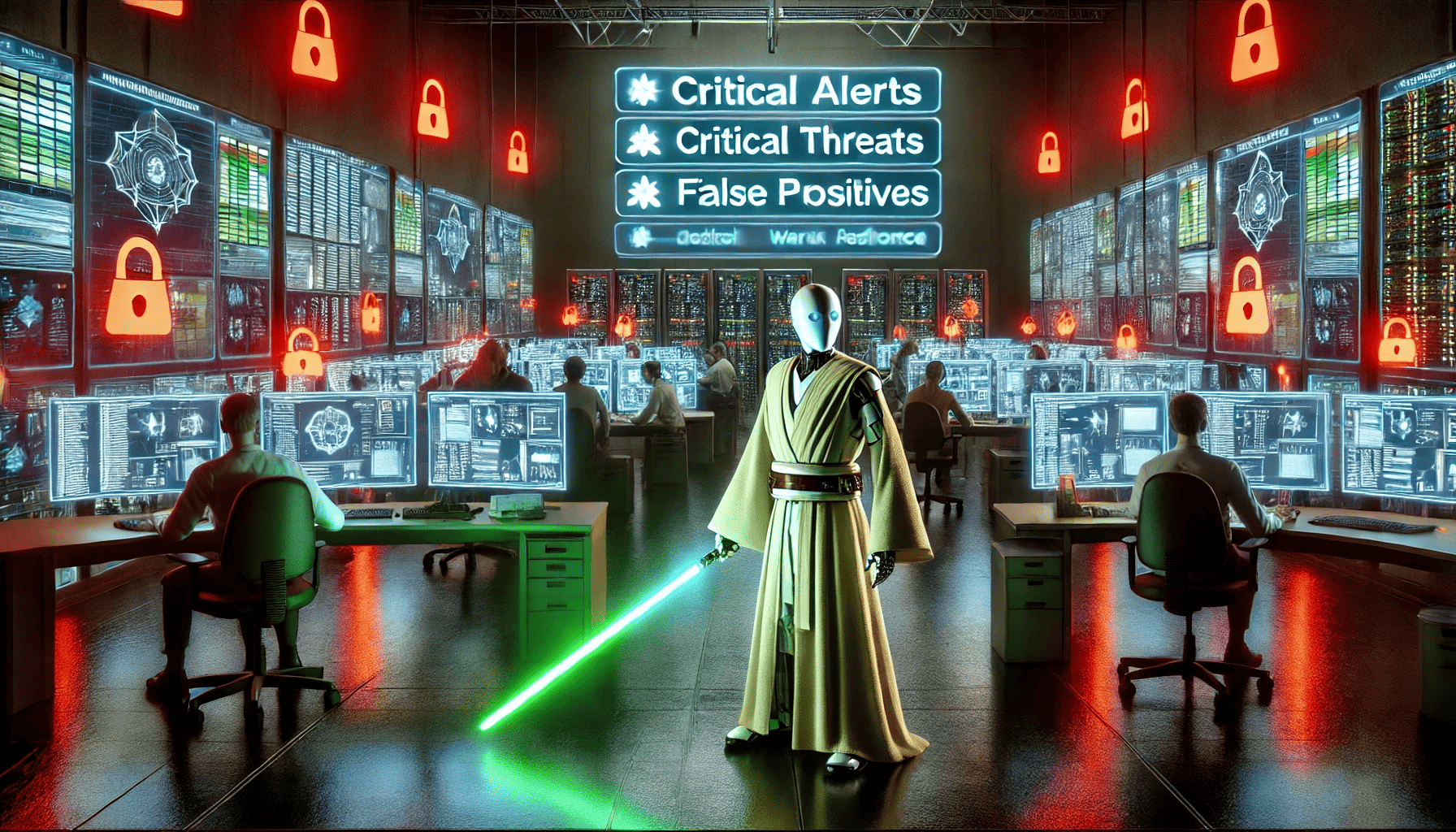Introduction
In an era where cyber threats are evolving rapidly, organizations face the daunting task of safeguarding their digital assets against increasingly sophisticated attacks. At the heart of this defense lies the Security Operations Center (SOC), staffed by dedicated professionals known as SOC analysts. These analysts are the frontline defenders, monitoring, detecting, and responding to threats that could compromise critical information systems.
This article delves into the essential role of SOC analysts in modern cybersecurity, exploring their responsibilities and the challenges they face. We’ll also examine how advancements like AI SOC solutions are reshaping the landscape, and how tools like SOC Jedi.AI are empowering analysts to meet today’s cybersecurity demands more effectively.
For a deeper understanding of the SOC analyst role and how AI is transforming the modern SOC, you can refer to our previous article: SOC Analysts: Meaning, Roles, and How AI Transforms the Modern SOC.
This article delves into the essential role of SOC analysts in modern cybersecurity, exploring their responsibilities and the challenges they face. We’ll also examine how advancements like AI SOC solutions are reshaping the landscape, and how tools like SOC Jedi.AI are empowering analysts to meet today’s cybersecurity demands more effectively.
For a deeper understanding of the SOC analyst role and how AI is transforming the modern SOC, you can refer to our previous article: SOC Analysts: Meaning, Roles, and How AI Transforms the Modern SOC.
Understanding the Role of SOC Analysts
Who Is a SOC Analyst?
A SOC analyst is a cybersecurity expert responsible for monitoring an organization’s network and systems to detect and respond to security incidents. Working within the SOC, they play a crucial role in identifying potential threats, analyzing alerts, and taking appropriate actions to mitigate risks.
Key Responsibilities
1. Continuous Monitoring
SOC analysts use various SOC tools to monitor network traffic, endpoints, servers, and applications. They analyze logs and alerts generated by intrusion detection systems, firewalls, and other security technologies to identify unusual activities that could indicate a security incident.
2. Incident Triage
A critical aspect of their role is incident triage, where they assess and prioritize security alerts based on severity and potential impact. This process ensures that the most critical threats are addressed promptly, minimizing potential damage.
3. Threat Analysis and Investigation
Analysts conduct in-depth investigations into suspicious activities. They leverage threat intelligence to understand the nature of threats, including malware analysis and identifying Indicators of Compromise (IoCs).
4. Response and Remediation
Upon confirming a security incident, SOC analysts coordinate response efforts, which may include isolating affected systems, eradicating malware, and restoring services. Collaboration with other IT and security teams is essential to implement remediation plans effectively.
5. Reporting and Documentation
Maintaining detailed records of security incidents is essential. Analysts document their findings, actions taken, and lessons learned to improve future responses and comply with regulatory requirements.
6. Continuous Learning
The cybersecurity landscape is ever-changing. SOC analysts must stay updated on the latest threats, vulnerabilities, and technologies to protect their organizations effectively.
A SOC analyst is a cybersecurity expert responsible for monitoring an organization’s network and systems to detect and respond to security incidents. Working within the SOC, they play a crucial role in identifying potential threats, analyzing alerts, and taking appropriate actions to mitigate risks.
Key Responsibilities
1. Continuous Monitoring
SOC analysts use various SOC tools to monitor network traffic, endpoints, servers, and applications. They analyze logs and alerts generated by intrusion detection systems, firewalls, and other security technologies to identify unusual activities that could indicate a security incident.
2. Incident Triage
A critical aspect of their role is incident triage, where they assess and prioritize security alerts based on severity and potential impact. This process ensures that the most critical threats are addressed promptly, minimizing potential damage.
3. Threat Analysis and Investigation
Analysts conduct in-depth investigations into suspicious activities. They leverage threat intelligence to understand the nature of threats, including malware analysis and identifying Indicators of Compromise (IoCs).
4. Response and Remediation
Upon confirming a security incident, SOC analysts coordinate response efforts, which may include isolating affected systems, eradicating malware, and restoring services. Collaboration with other IT and security teams is essential to implement remediation plans effectively.
5. Reporting and Documentation
Maintaining detailed records of security incidents is essential. Analysts document their findings, actions taken, and lessons learned to improve future responses and comply with regulatory requirements.
6. Continuous Learning
The cybersecurity landscape is ever-changing. SOC analysts must stay updated on the latest threats, vulnerabilities, and technologies to protect their organizations effectively.
Challenges Facing SOC Analysts Today

Increasing Volume of Security Alerts
With the proliferation of security technologies, SOC analysts are inundated with alerts. Alert fatigue becomes a significant issue as analysts may overlook or misprioritize critical threats due to the overwhelming volume of notifications.
Sophisticated Cyber Threats
Cyber adversaries employ advanced tactics, techniques, and procedures (TTPs) to bypass traditional security measures. The rise of zero-day exploits, ransomware, and advanced persistent threats (APTs) requires analysts to be more vigilant and knowledgeable than ever.
Skill Shortage
There is a global shortage of skilled cybersecurity professionals. Organizations struggle to recruit and retain qualified SOC analysts, leading to understaffed teams and increased workload for existing staff.
Evolving Technology Landscape
The rapid adoption of cloud services, Internet of Things (IoT) devices, and remote work models has expanded the attack surface. Analysts must adapt to monitor and secure these diverse environments effectively.
With the proliferation of security technologies, SOC analysts are inundated with alerts. Alert fatigue becomes a significant issue as analysts may overlook or misprioritize critical threats due to the overwhelming volume of notifications.
Sophisticated Cyber Threats
Cyber adversaries employ advanced tactics, techniques, and procedures (TTPs) to bypass traditional security measures. The rise of zero-day exploits, ransomware, and advanced persistent threats (APTs) requires analysts to be more vigilant and knowledgeable than ever.
Skill Shortage
There is a global shortage of skilled cybersecurity professionals. Organizations struggle to recruit and retain qualified SOC analysts, leading to understaffed teams and increased workload for existing staff.
Evolving Technology Landscape
The rapid adoption of cloud services, Internet of Things (IoT) devices, and remote work models has expanded the attack surface. Analysts must adapt to monitor and secure these diverse environments effectively.
How AI is Transforming the SOC Analyst’s Job
Introduction to AI SOC Solutions
Artificial intelligence is revolutionizing cybersecurity by automating complex tasks, enhancing threat detection, and providing actionable insights. AI SOC solutions augment analysts’ capabilities, allowing them to focus on strategic initiatives.
Automating Routine Tasks
SOC automation through AI reduces the manual effort required for tasks like log analysis, alert correlation, and incident report generation. AI algorithms can automate the actions that analysts take when compiling an incident (alert) report, saving time and freeing them from routine tasks.
Enhancing Threat Detection and Response
AI algorithms can analyze vast amounts of data to identify patterns and anomalies indicative of cyber threats. By automating these processes, AI enables faster and more accurate detection, leading to quicker response times.
Enrichment in Threat Intelligence
AI enhances enrichment in threat intelligence by gathering data from both external and internal sources. It takes into context user groups, their permissions, previous alerts (incidents), and other internal data, greatly improving the quality of investigations.
Artificial intelligence is revolutionizing cybersecurity by automating complex tasks, enhancing threat detection, and providing actionable insights. AI SOC solutions augment analysts’ capabilities, allowing them to focus on strategic initiatives.
Automating Routine Tasks
SOC automation through AI reduces the manual effort required for tasks like log analysis, alert correlation, and incident report generation. AI algorithms can automate the actions that analysts take when compiling an incident (alert) report, saving time and freeing them from routine tasks.
Enhancing Threat Detection and Response
AI algorithms can analyze vast amounts of data to identify patterns and anomalies indicative of cyber threats. By automating these processes, AI enables faster and more accurate detection, leading to quicker response times.
Enrichment in Threat Intelligence
AI enhances enrichment in threat intelligence by gathering data from both external and internal sources. It takes into context user groups, their permissions, previous alerts (incidents), and other internal data, greatly improving the quality of investigations.
The Benefits of AI Integration in the SOC

Reducing Alert Fatigue
By automating the analysis of security alerts and filtering out false positives, AI reduces the number of alerts that SOC analysts need to manually investigate, alleviating alert fatigue.
Improving Efficiency and Accuracy
Automation and AI-driven insights accelerate the detection and response process, allowing analysts to handle more incidents effectively. AI minimizes human errors, enhancing the overall security posture.
Enabling Analysts to Focus on Critical Tasks
With routine tasks automated, analysts can dedicate more time to strategic initiatives, such as improving security policies, compliance efforts, and advanced threat analysis.
By automating the analysis of security alerts and filtering out false positives, AI reduces the number of alerts that SOC analysts need to manually investigate, alleviating alert fatigue.
Improving Efficiency and Accuracy
Automation and AI-driven insights accelerate the detection and response process, allowing analysts to handle more incidents effectively. AI minimizes human errors, enhancing the overall security posture.
Enabling Analysts to Focus on Critical Tasks
With routine tasks automated, analysts can dedicate more time to strategic initiatives, such as improving security policies, compliance efforts, and advanced threat analysis.
Case Study: SOC Jedi.AI in Action
Empowering SOC Analysts with SOC Jedi.AI
SOC Jedi.AI is an advanced AI-driven platform designed to augment SOC analysts’ capabilities. Acting as a cybersecurity team copilot, it streamlines incident investigation, enhances efficiency, and boosts precision in threat detection and response.
Key Outcomes with SOC Jedi.AI
SOC Jedi.AI is an advanced AI-driven platform designed to augment SOC analysts’ capabilities. Acting as a cybersecurity team copilot, it streamlines incident investigation, enhances efficiency, and boosts precision in threat detection and response.
Key Outcomes with SOC Jedi.AI
- 95% Reduction in Manual Triage
- 80% Faster Incident Response
- Improved Quality of Investigations
Understanding Threat Intelligence Observables

What is a Threat Intelligence Observable?
A threat intelligence observable is any piece of information that can be used to identify malicious activity. This includes IP addresses, domain names, URLs, file hashes, email addresses, and more.
Role in Cybersecurity
Analyzing observables helps analysts detect and investigate potential threats. By correlating observables with known malicious activity, analysts can identify Indicators of Compromise and respond appropriately.
Integration with AI Tools
AI platforms like SOC Jedi.AI automatically collect and analyze observables from various sources, providing analysts with actionable intelligence and reducing the time required for manual research.
A threat intelligence observable is any piece of information that can be used to identify malicious activity. This includes IP addresses, domain names, URLs, file hashes, email addresses, and more.
Role in Cybersecurity
Analyzing observables helps analysts detect and investigate potential threats. By correlating observables with known malicious activity, analysts can identify Indicators of Compromise and respond appropriately.
Integration with AI Tools
AI platforms like SOC Jedi.AI automatically collect and analyze observables from various sources, providing analysts with actionable intelligence and reducing the time required for manual research.
Conclusion
SOC analysts are indispensable in the fight against cyber threats. Their role in monitoring, detecting, and responding to security incidents is crucial for protecting organizational assets. However, they face significant challenges, including alert fatigue, sophisticated threats, and skill shortages.
The integration of AI SOC solutions like SOC Jedi.AI is transforming the modern SOC. By automating routine tasks, enhancing threat detection, and providing enriched intelligence from both external and internal sources, AI empowers analysts to focus on strategic initiatives and respond more effectively to threats.
For CISOs, Heads of Cybersecurity, SOC managers, CIOs, and other decision-makers, investing in AI-driven platforms is not just a technological upgrade but a strategic imperative. It enhances security posture, improves operational efficiency, and positions the organization to meet current and future cybersecurity challenges.
The integration of AI SOC solutions like SOC Jedi.AI is transforming the modern SOC. By automating routine tasks, enhancing threat detection, and providing enriched intelligence from both external and internal sources, AI empowers analysts to focus on strategic initiatives and respond more effectively to threats.
For CISOs, Heads of Cybersecurity, SOC managers, CIOs, and other decision-makers, investing in AI-driven platforms is not just a technological upgrade but a strategic imperative. It enhances security posture, improves operational efficiency, and positions the organization to meet current and future cybersecurity challenges.
Ready to Transform Your SOC Operations?
Discover how SOC Jedi.AI can empower your security team to tackle modern cyber threats with unparalleled efficiency and accuracy. Contact us today to schedule a demo and take the first step toward a more secure future.


